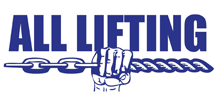
BASIC SLING CONFIGURATIONS: A USER GUIDE
If you need to use lifting slings to complete a job; it is important that you understand the application and the different configurations, so that you choose the best one to handle and control your load. Selecting the correct configuration is as important as choosing your lifting sling.
A load can be rigged and moved in many ways, therefore, there are a few different types of configurations that will assist you with the requirement. The three most common configurations are vertical, basket and choker configurations.
![]() Vertical Sling Configuration
Vertical Sling Configuration
Vertical configuration is probably the most common one of all. Whether you are using a synthetic rope, chain or wire rope sling, there will be a hook that connects to the load and the top of the sling will connect to the lifting device.
Basket Sling Configuration  This type of sling configuration helps to distribute the load equally between the two legs of a sling. When using a basket configuration, the load is supported by the two parts of the sling and then connecting to an oblong link, as demonstrated in the picture below.
This type of sling configuration helps to distribute the load equally between the two legs of a sling. When using a basket configuration, the load is supported by the two parts of the sling and then connecting to an oblong link, as demonstrated in the picture below.
Choker Sling Configuration A choker sling configuration is often used to tighten a sling down securely to provide better load control. When using a choker configuration, one eye of the sling is wrapped around the load, then passed through the sling itself and attached to the crane or hoist hook.
A choker sling configuration is often used to tighten a sling down securely to provide better load control. When using a choker configuration, one eye of the sling is wrapped around the load, then passed through the sling itself and attached to the crane or hoist hook.
Due to pressures created at the choke point, a choker configuration could reduce the lifting capacity to even less than 50% of the working load depending on the angle that the load is positioned, however, the least amount of capacity reduction occurs when the angle of the choke is 120°. This angle should never be exceeded.

Remember, that it is very important that your lifting gear is periodically inspected, to make sure that your equipment is in proper working condition and rated for the specific job. If you require any assistance with your lifting task, do not hesitate to contact us on 1300 666 733 or email us on info@alllifting.com.au and one of our experienced specialists will assist you.



